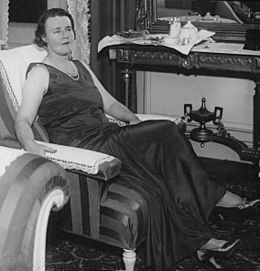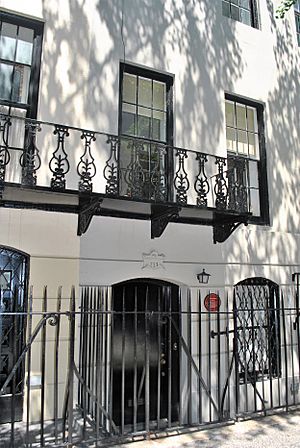Dorothy Thompson facts for kids
Quick facts for kids
Dorothy Thompson
|
|
|---|---|

Thompson in 1930
|
|
| Born |
Dorothy Celene Thompson
July 9, 1893 Lancaster, New York, U.S.
|
| Died | January 30, 1961 (aged 67) Lisbon, Portugal
|
| Education | Lewis Institute Syracuse University |
| Spouse(s) |
Joseph Bard
(m. 1923; div. 1927)Maxim Kopf
(m. 1945; died 1958) |
| Children | 2 |
Dorothy Celene Thompson (born July 9, 1893 – died January 30, 1961) was an American journalist and radio broadcaster. She was the first American journalist to be kicked out of Nazi Germany in 1934. She was also one of the few women news commentators on radio in the 1930s. Many people called her the "First Lady of American Journalism." Time magazine said in 1939 that she was as important as Eleanor Roosevelt.
Contents
Dorothy Thompson's Early Life and Education
Dorothy Thompson was born in Lancaster, New York, in 1893. She was one of three children. Her mother died when Dorothy was seven years old. Her father, Peter, was a Methodist preacher. He raised his children alone.
Dorothy did not get along with her new stepmother. So, in 1908, her father sent her to Chicago. She lived there with her two aunts. Dorothy went to Lewis Institute for two years. Then she went to Syracuse University. She studied politics and economics there. She graduated in 1914.
Unlike many women at that time, Dorothy had the chance to go to college. She felt it was her duty to fight for women's right to vote. This belief became a strong part of her political views. After college, she moved to Buffalo, New York. She worked there for the women's suffrage movement until 1920.
Becoming a Journalist in Europe

In 1920, Dorothy Thompson moved to Europe. She wanted to start her career as a journalist. She was very interested in the early movement to create a Jewish homeland, called Zionism.
Her big chance came when she visited Ireland in 1920. She was the last person to interview Terence MacSwiney. He was a major leader of the Sinn Féin movement. He was arrested days later and died two months after that. Because of her success, she became a reporter in Vienna for the Philadelphia Public Ledger.
While working in Vienna, Dorothy learned to speak German fluently. In 1925, she became the head of the Central European news for the Public Ledger. She left that job in 1927. Soon after, the New York Post hired her to lead their office in Berlin, Germany. There, she saw the rise of the Nazi party firsthand. Her biographer, Peter Kurth, said she was "the undisputed queen of the overseas press corps." She was the first woman to lead a foreign news office of such importance.
Dorothy Thompson made many friends with German writers during this time. These included authors like Thomas Mann and Bertolt Brecht.
Reporting on Adolf Hitler
Dorothy Thompson's most important work abroad happened in Germany in the early 1930s. She met and interviewed Adolf Hitler in 1931 in Munich. This interview became the basis for her book, I Saw Hitler. In the book, she warned about the dangers if Hitler gained power in Germany.
She described Hitler as "formless, almost faceless." She said he seemed "inconsequent and voluble, ill poised and insecure." She called him "the very prototype of the little man."
Later, when the Nazis became very powerful, people asked Thompson about her "little man" comments. It seemed she had underestimated Hitler. The Nazis found her book and articles offensive. In August 1934, Dorothy Thompson was forced to leave Germany. She was the first American journalist to be expelled.
Dorothy Thompson's Work in America
In 1936, Dorothy Thompson started writing a newspaper column called "On the Record." It appeared in the New York Herald Tribune and was shared with over 170 other newspapers. More than ten million people read it. She also wrote a monthly column for the Ladies' Home Journal for 24 years. These columns were about topics like gardening, children, and art.
Radio Broadcasts and Helping Refugees
Around the same time, NBC hired Thompson as a news commentator. She worked for NBC from 1936 to 1938. Her radio shows became very popular in the United States. This made her one of the most sought-after female public speakers. When Nazi Germany invaded Poland in 1939, Thompson broadcast on the radio for fifteen days and nights in a row.
In 1938, Thompson spoke out to help a young Jewish teenager named Herschel Grynszpan. An event involving him was used by the Nazis to start the terrible events of Kristallnacht in Germany. Thompson's radio broadcast on NBC was heard by millions. It led to many people showing support for the young man. More than $40,000 was collected to help his legal case.
Changing Views on Zionism
Dorothy Thompson had supported the Zionist movement since 1920. This movement aimed to create a Jewish homeland. In the late 1930s, she became a strong supporter for Jewish refugees escaping danger in Europe. She worked closely with Zionist leaders. As World War II continued, Thompson became a strong advocate for the movement.
However, her views began to change after a trip to Palestine in 1945. She became worried about some extreme groups within the movement. After writing articles that criticized these groups, she faced a lot of disagreement. She eventually felt that the path Zionism was taking could lead to endless conflict. As her distance from the Zionist movement grew, she began to support Palestinian refugees. After traveling to the Middle East in 1950, she helped start the American Friends of the Middle East.
Dorothy Thompson's Personal Life
Dorothy Thompson was married three times. Her most famous marriage was to her second husband, Sinclair Lewis. He won the Nobel Prize in Literature.
In 1923, she married her first husband, Joseph Bard. They divorced in 1927. Thompson married Sinclair Lewis in 1928. They had one son, Michael Lewis, born in 1930. The couple divorced in 1942. She married her third husband, artist Maxim Kopf, in 1945. They were married until he died in 1958.
Dorothy Thompson died in 1961, at age 67, in Lisbon, Portugal. She is buried in Barnard, Vermont.
Dorothy Thompson's Books
- 1928: The New Russia
- 1932: I Saw Hitler!
- 1935: Maps
- 1938: Dorothy Thompson's Political Guide
- 1938: Refugees: Anarchy or Organization?
- 1937: Concerning Vermont
- 1939: Once on Christmas
- 1939: Let the Record Speak
- 1939: Christian Ethics and Western Civilization
- 1941: A Call to Action, Ring of Freedom
- 1941: Our Lives, Fortunes, and Sacred Honor
- 1941: Who Goes Nazi?
- 1942: Listen, Hans
- 1944: To Whom Does the Earth Belong?
- 1945: Wrangled by Two Cowboys
- 1945: I Speak Again as a Christian
- 1946: Let the Promise Be Fulfilled: A Christian View of Palestine
- 1948: The Truth About Communism
- 1948: The Developments of Our Times
- 1955: The Crisis of the West
- 1957: The Courage to Be Happy
See also
 In Spanish: Dorothy Thompson para niños
In Spanish: Dorothy Thompson para niños
- List of suffragists and suffragettes
- List of women's rights activists
- Timeline of women's suffrage



